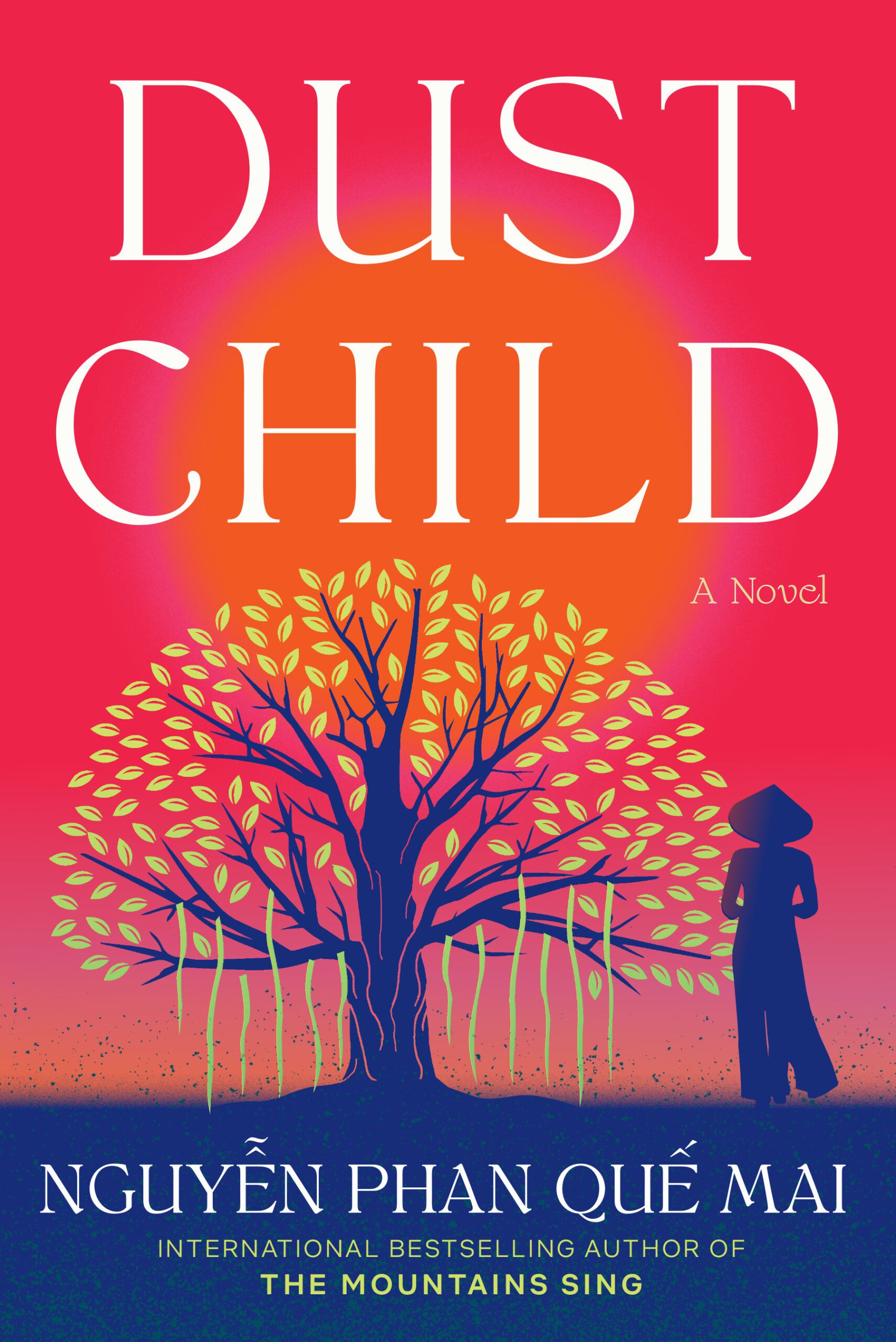Featured image: A village craftswoman near Ho Chi Minh City, Vietnam | Photo from Envato by thananit_s
Set in Vietnam, Dust Child offers a compassionate lens
by Tina Hartas
Four lives, entwined forever by decisions made in a time of conflict. But what happens decades later when they unexpectedly converge once more? Set in 1969 and the present day, Dust Child, by Nguyễn Phan Quế Mai, tells the story of sisters Trang and Quỳnh. Desperate to help their parents pay off debts, the girls leave their rural village and become “bar girls” in Sài Gòn, drinking, flirting (and more) with American GIs in return for money. As the war moves closer to the city, the once-innocent Trang gets swept up in an irresistible romance with a young and charming American helicopter pilot.
In present day, Phong is one of the thousands of mixed-race children abandoned by their American fathers and Vietnamese mothers. Phong grows up surrounded by rejection, insulted as a ‘Black American imperialist’, and a ‘child of the enemy’. But he never gives up hope of finding his parents and proving he is more than a ‘bui doi’: more than the ‘dust of life’. Then there’s Dan, a former American helicopter pilot still plagued by regrets about his actions during the Việt Nam war. Now he has returned in the hope of confronting the demons that refuse to fall silent. Set between the Việt Nam war and the present day, Dust Child is a sweeping epic of family secrets and hidden heartache, from an internationally celebrated author.
“Throughout his life, [Phong] had been called the dust of life, bastard, Black American imperialist, child of the enemy. These labels had been flung at him when he was younger and with such ferocity that they had burrowed deep within him, refusing to let go.” – Dust Child, page 2.
About the Author of Dust Child
Born and raised in Việt Nam, Dr. Nguyễn Phan Quế Mai (pronounced ŋwiən fα:n kwey mai) is the author of the global best-selling novels The Mountains Sing and Dust Child, Winner of the BookBrowse Best Debut Award, the International Book Awards, the PEN Oakland/Josephine Miles Literary Award, the Nota Bene Prize, the Rhegium Julii Award, the Lannan Literary Award Fellowship for Fiction, as well as Runner-up for the Dayton Literary Peace Prize.
She has published 12 books of poetry, fiction, and non-fiction in Vietnamese and English and has received some of the top literary prizes in Việt Nam. Her writing has been translated into more than twenty languages and has appeared in major publications, including The New York Times. Quế Mai is a translator of ten books of poetry and fiction from English into Vietnamese and vice versa. She has a PhD in creative writing from the UK’s Lancaster University. She is an advocate for the rights of disadvantaged groups in Việt Nam and was named by Forbes Việt Nam as one of twenty inspiring women of 2021. To learn more visit her website here.
Read More: Discover Asia and India with These 10 Books
Book Club Discussion Questions: Dust Child
Prepared by Sally Anne Smith
A note about our use of diacritics in these questions
Many of us try to learn a few words or phrases of local languages when we travel. We often find this easier when the alphabet is similar to our own, helping us to sound out words we see on shop signs, menus and tourist information boards. The University of Sussex defines diacritics as “the various little dots and squiggles which, in many languages, are written above, below or on top of certain letters of the alphabet to indicate something about their pronunciation.” Because they aren’t used much in English, many of us tend to think of them as optional punctuation.
Far from it! In her author notes, Nguyễn Phan Quế Mai explains that they are essential for communication. The combinations of letters spelled as nha, for example, is actually six completely separate words with different meanings. Depending on whether and where we place the diacritical marks, nha could mean anything from elegant, to house, to teeth, or something else entirely.
In Dust Child, diacritics are used to denote changes in speakers, even occasionally using diacritical marks when Vietnamese characters are speaking in English. But the narrative takes this further, showing how an American character’s changing attitude to the importance of diacritics reflects his growing respect for Việt Nam and the Vietnamese people.
It’s sometimes difficult for us to pronounce words with the correct sounds and intonations, and we can find unfamiliar diacritics difficult to comprehend. As a step towards understanding their significance, we’ve tried our best to get the diacritics right in our discussion questions by, for example, following the author’s practice in using diacritics in “Việt Nam” but not in “Vietnamese”.
1. The story is set in Việt Nam. Have you ever travelled there? Did any of the passages feel familiar to you from your own travels?
2. What was your favourite passage in the book, and why?
3. The skyline of the Hồ Chí Minh City Dan visited with his wife Linda in 2016 had changed dramatically from the skyline of the Sài Gòn he’d known during the war. (Page 17) Have you ever travelled to a destination after many years’ absence? Did you find it familiar or changed – or both?
4. What did you think about Linda and Dan’s relationship with their guide Thiên at the beginning of their trip? How – and why – did it evolve over time?
5. When the bellhop bows to Dan, he returns the bow and notes how much he dislikes it when other Western guests ignored the gesture. (Page 71) Have you ever learnt and practiced small gestures of etiquette on your travels? Has this enhanced your experience?
6. Why do you think Trang was first attracted to Dan? How did Dan change over the time that she knew him? Did Trang change too?
7. How do you think family members of soldiers are affected by the trauma of war? How was this illustrated through the experiences of Linda and Thanh (the son of the veteran who suffers from Alzheimer’s disease, introduced to the story on page 241-249)?
8. Phong felt liberated by his eventual decision to give up on trying to get a visa for the States. (Page 302) Do you think he was right to relinquish this childhood dream?
9. Were you surprised to find out who Phong’s parents were, or did you see this twist coming?
10. Toward the end of the book, Dan acknowledges that “All his life, he’d expected people from around the world to know English, to translate their life experiences to serve people like him.” Why do you think English is viewed this way by so many?
11. In Dust Child, Vietnamese words appear with their full diacritical marks in passages written from the viewpoints of Vietnamese speakers. Sometimes, English words are shown with diacritical marks too. How did this affect your reading experience?
12. Before reading this book, did you know that diacritical marks are necessary to correctly interpret written words in Việt Nam? What did you think of Dan’s changing attitude to the use of diacritics?
13. What did you think of the character of Quỳnh? Did you like her? Do you think she made the best decisions for the children in her family?
14. Reading is important to Dan, and to his relationship with Trang. At one point, he reflects “Conversation about books represented the most intimate discourse. It revealed a person’s values, beliefs, fears, and hopes. Experiencing the same books enabled people to travel on similar journeys and brought them closer together,” Do you agree with his statement? Has your book club enriched your life? If so, how?
15. Did you learn anything about the children born of American soldiers during the Việt Nam War in particular, or the country of Việt Nam in general, through reading this book?
16. Did the book make you want to travel to Việt Nam?
Read More: Sign up for our book club newsletter here
More on Vietnam
Places to Dream About: Top 10+ Reader Tips for May 2021
Our May travel tips include female-friendly advice to inspire future travel dreams to places like France, Ecuador, Japan and more!
Mind Your Manners Around the World …
Whether you are travelling for business or pleasure it is more than important for guests to be culturally correct at the table. Here are sixteen tips to assist you in 16 different countries.
She Learns to Cross Streets in Ho Chi Minh City, Vietnam
On a recent trip to Ho Chi Minh City (HCMC) I departed drastically from my usual pattern. The bargains available in this city are fabulous and the locals are wonderfully adept at charming you out of your last U.S. dollar or Vietnamese dong.







0 Comments
We always strive to use real photos from our own adventures, provided by the guest writer or from our personal travels. However, in some cases, due to photo quality, we must use stock photography. If you have any questions about the photography please let us know.
Disclaimer: We are so happy that you are checking out this page right now! We only recommend things that are suggested by our community, or through our own experience, that we believe will be helpful and practical for you. Some of our pages contain links, which means we’re part of an affiliate program for the product being mentioned. Should you decide to purchase a product using a link from on our site, JourneyWoman may earn a small commission from the retailer, which helps us maintain our beautiful website. JourneyWoman is an Amazon Associate and earns from qualifying purchases. Thank you!
We want to hear what you think about this article, and we welcome any updates or changes to improve it. You can comment below, or send an email to us at [email protected].